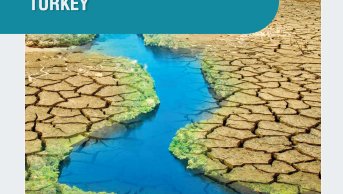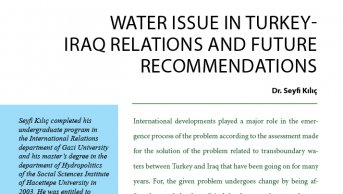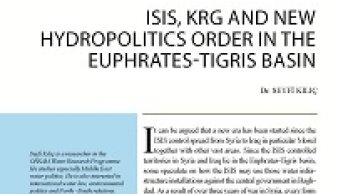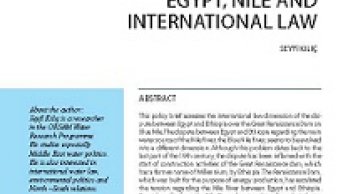Linking the Congo River to the Nile as Egypt's Other Alternative

It might be suggested that with Ethiopia's starting to construct the Grand Renaissance dam on the Blue Nile River, Egypt's years of dominance over the Nile has almost come to an end. Egypt, both under British rule and also after gaining its independence, signed many bilateral and multilateral agreements with other countries in the basin in order for the Nile River waters to reach Egypt without being interrupted. However, none of these agreements covered all countries in the basin. Besides, countries in the basin declared that they did not recognize the agreements signed by Britain on their behalf, even if in other forms after their independence. Egypt has expressed its discomfort on every occasion after Ethiopia started the construction of dam in 2010, and declared to the public that it could even take military measures to prevent the dam's construction during the rule of Morsi who was ousted by a coup d’etat. A series of negotiations have taken place between Egypt, Sudan and Ethiopia in the meantime, but the parties have failed to reach an agreement to fulfill each party's expectations. Egypt asserts that the amount of water to reach the country will dramatically diminish due to the aforesaid dam under construction. Despite the fact that the Grand Renaissance dam on the Blue Nile river which contributes 85% of the Nile water is primarily designed for hydroelectric power generation, not involving any water consuming activity, apparently Egypt is insistent in its claim. Considering the positions in the negotiations, Egypt's desire to guarantee its future uses of the river water is stated explicitly.
Within the framework of the 1959 agreement between Egypt and Sudan; 55 billion cubic meters of the annual flow of 84 billion cubic meters of the water was allocated to Egypt. The average annual evaporation loss was estimated 10 billion cubic meters, leaving the 74 billion cubic meter allocation to Egypt and Sudan. The allocation of water in the 1959 agreement is determined as follows: The 1929 agreement gives Egypt 48 billion cubic meters of water annually and Sudan 4 billion cubic meters, which leaves 22 billion cubic meters of flow annually that is shared between Egypt (7,5 billion cubic meters) and Sudan (14,5 billion cubic meters). This being the case, the agreement allocated 55.5 billion cubic meters of the water to Egypt and 18 billion cubic meters to Sudan. In case of exceeding the estimated amount, it was agreed that the excess quantity would be shared equally between the two countries.
The agreement signed in the midst of the 20th century cannot respond to the current complex socio-economic and political situation. Each of the eleven states in the basin has different social structure, economy and priorities. Expecting from these countries to ignore such a major resource as the Nile River, which also aim a rapid economic development, clashes with today's reality. In a country like Ethiopia with rapid population growth where the population needs a cheap and reliable resource for the growing industry in addition to meeting its electricity need, hydroelectric power comes to the fore due to the convenient features of topography. Therefore, it cannot be expected from Ethiopia to give up on its dam construction decision on the Blue Nile River. On the contrary, Ethiopia has ambitious plan such as becoming the energy supplier of Africa. Ethiopia asserting that the dam to be built on the river will be for the benefit of the entire basin and will provide cheap energy, which reinforces the argument, seems to have impressed Sudan, Egypt's historical ally on the Nile River, as well. In the statements by various Sudanese officials, the dam Ethiopia has been constructing is considered “in the interest” of all riparian countries. Sudan's desire to use the Nile river water in its borders is what underlies such statements. The White Nile which originates at Lake Victoria and the Blue Nile which originates in Ethiopia meet in Sudan and then flow towards Egypt. Therefore, Sudan wants to benefit from this resource, and has been carrying out some activities to improve water resources especially with the support of China's financial and technical support. Despite the 1959 agreement signed with Egypt, it might be assessed that it has supported the upper riparian Ethiopia's activities to justify the aforesaid ones.
Considering that the Grand Renaissance dam is being constructed with the aim to generate hydroelectric power, it is known that there will not be any loss of water to reach Egypt, except for the evaporation losses. However, it must be taken into account that there will be certain amount of water loss during the filling of the dam temporarily while letting water to flow into lower riparians. Egypt alleges that there will be a loss in the flow of water during the filling, and also a permanent loss will occur in the flow after the completion of the construction, and thus future utilizations will be jeopardized. Egyptian claims on the future utilization of the Nile waters, to prevent current utilization of the river water by upstream countries does not seem to be in accordance with the international law.
Former Projects Aiming to Increase the Flow in the Basin
Various plans have been brought forward to increase the flow of the Nile river since the British rule. It was in 1904 that British engineers first proposed the “Century Storage Scheme” which aimed to collect the floodwaters of the Nile outside Egypt, and afterwards it was further elaborated into this scheme. It was intended to ensure that the irrigation would not be negatively affected by drought through the water to be stored during the periods with high rate of flow. The construction of a dam on Lake Tana in Ethiopia at the sources of the Blue Nile, a dam on Lake Victoria shared by Tanzania, Kenya and Uganda at the sources of the White Nile were envisaged in the scheme. Also construction of a canal through the swamps of the Sudd, which the White Nile flows into after crossing the Sudanese borders, was planned to increase the amount of water available, by diminishing evaporation losses. Besides, it was envisaged to construct a series of dams in Sudan. However, this plan was criticized by Egyptian nationalists for all the main structures were located outside Egypt. Egyptian nationalists believed that this plan could be used by Britain to control Egypt in case Egypt gained its independence.
Another plan similar to that of British was put forward by Egyptians in 1949. The plan called, “Protection of the Nile River Water in the Future” was a two-stage plan. Accordingly, in the first stage, it was envisaged to install regulators in Lake Albert and Lake Victoria each and construct another dam in the river mouth of the Lake Victoria; to construct the Jonglei canal on the swamps of the Sudd; to construct a dam to use the Lake Tana, source of the Blue Nile, as a reservoir; and to construct another one in the fourth waterfall located in the Sudanese borders. In the second stage, on the other hand, there were projects to prevent loss of water in the Bahr el Ghazal and Sobat river basins, and it was aimed to supply an additional amount of water ranging form 4,4 to 7 cubic kilometers of water per year. However, not much research was conducted for the second-stage plans.
Egypt has to gain new agricultural lands to feed its increasingly growing population which has almost reached 90 million. To that end, Egypt has brought forward the New Valley Project. The valley has been projected to become home to new residential areas and arable lands all along the oases in the west of the Nile valley; and thus Egypt plans to ease the pressure on the Nile valley, and to pave the way for new arable lands and residential areas. The New Valley Project aims to irrigate 300,000 to 500,000 ha.
On the other hand, Egypt has been conducting a large-scale project titled, 'the North Sinai Agricultural Development Project (NSADP)' in northern Sinai desert for many years. It is estimated that the total cost of the project will be 1,5 billion US dollars. Within the scope of the project, lands located in the west of the Suez Canal have been irrigated since 1987. Egypt completed the canal conducting the Nile water into the Sinai peninsula as far as El Arish on the border to the Gaza Strip. The canal is suggested to be extended to the Gaza Strip, and even to Israel in order to contribute to overcome the water shortage in the region. The first proposal in this context was made by Thedor Herzl, head of the World Zionist Organization, in 1902; and it was proposed again by the President Anwar as-Sadat after the 1979 Camp David Peace Treaty signed with Israel. Nevertheless, it is largely opposed in Egypt. In addition to this, it is obvious that Egypt which opposes to upstream riparians in developing any water resource for security reasons will not be taken seriously by the countries in the basin after transferring water outside the basin like this.
Linking the Nile to the Congo River
Within the scope of two projects mentioned above, it is inevitable for Egypt to have an additional need for water. Adding rapidly growing population to the aforesaid projects, Egypt's dependence on the Nile River waters further increases. Continuation of the flow reaching Egypt does not seem likely to prevent the upstream countries from using the river water. It is assessed that linking the Nile to the Congo River, brought forward in the early 20th century to this end, might be brought up to the agenda again. The Congo River water amounts to 1000 billion cubic meters annually, and discharges approximately 14 times more amount of water than the Nile River. Transferring a certain amount of this water into the White Nile that originates at Lake Victoria through a canal to be opened is considered an important plan to increase the water flow. The first plan was put forward by an Egyptian chief engineer Apata Pasha in Sudan in 1902, but failed to be implemented. No initiative was taken for the plan which was brought forward again by Mubarak in 1981 after he was elected as President of Egypt. Although Egypt's statements on the project seemed unfavorable, possibilities which currently seem utopian to meet the water demand in the future should be taken into consideration as well. Contribution from the Congo River, of which average flow rate is 41,000 cubic meters per second, to the Nile River, of which average flow rate is 2800 cubic meters per second, would eliminate the problems in the Nile river and especially make it possible for Egypt to carry out the projects mentioned above. Although inter-basin water transfers have potential of causing environmental, financial and socio-economic problems, the amount of water to be transferred in this example is relatively low to the total amount, reduces such risks. Southern Juba, capital of Southern Sudan, appears to be the junction point the Nile River to the canal. Also, there are certain technical difficulties for such a canal. Large pumping stations are required to be built due to the height difference between the Congo River and the Nile River. But it is also asserted that the hydroelectric potential is quite high due to the difference of discharge of water to be transferred afterwards. In addition to this, there is a major hydroelectric potential in Southern Sudan along the White Nile River. On the other hand, the rising amount of water would have positive impact on the hydroelectric generation in the Aswan dam in Egypt. Besides, sea-water intrusion that has been observed in the Nile delta because of the scarcity of flow rate will be prevented and precious arable lands will be prevented from being lost. It is known that the project has been leaned towards by the Southern Sudanese government. Southern Sudan believes that in this way it could become prominent in energy generation across Africa. Moreover, new roads to be built within the framework of the canal and hydroelectric plant constructions which could link northern-southern and eastern-western parts of Africa are among positive repercussions of the project. Even though the Egyptian government remains distant to the project for now, it is known that Egypt's Mineral Resources Authority has been carrying out a study on the project. It is assessed that the countries in the basin and particularly Egypt will work harder on the project in the upcoming years.










